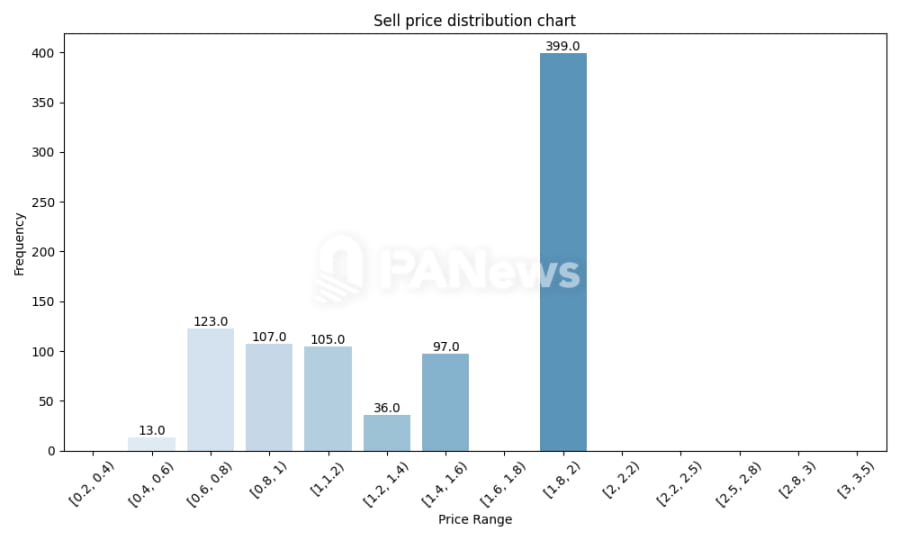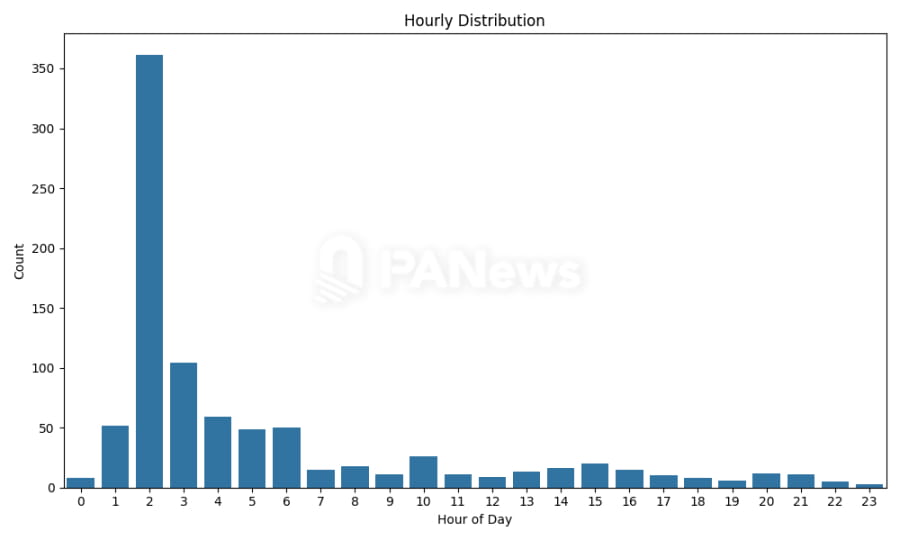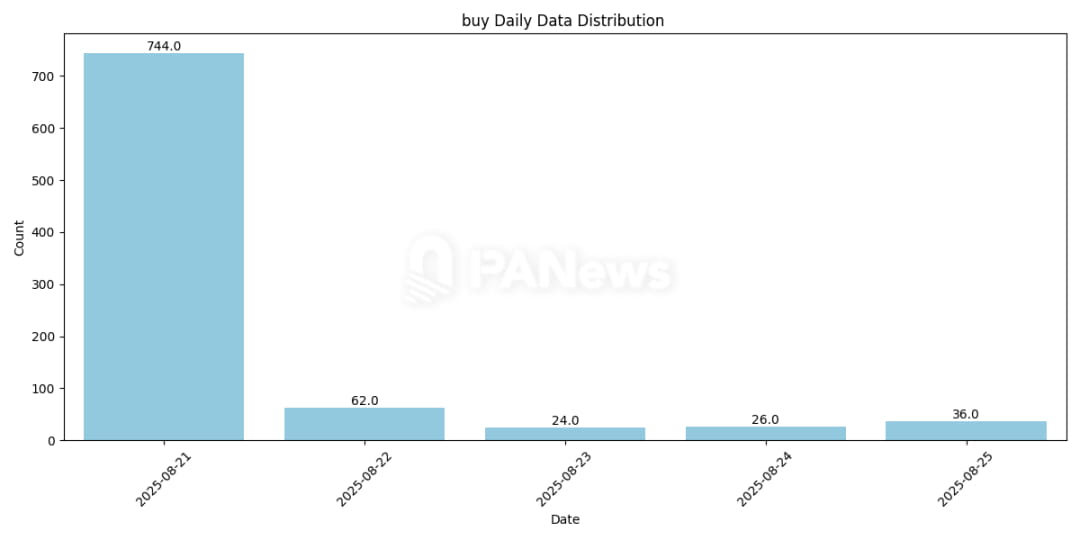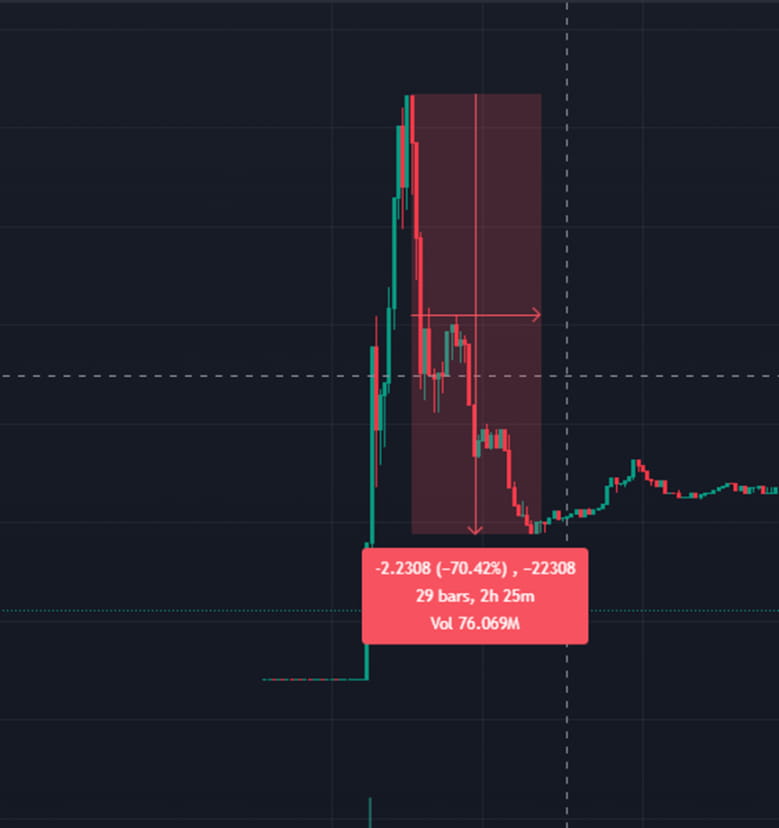Written by Frank, PANews
The celebrity cryptocurrency market is experiencing renewed excitement. On August 21st, Kanye West, the world's most influential yet controversial artist, suddenly announced the release of his personal MEME token, YZY. Its market capitalization quickly surged to over $3 billion. Within hours, some investors profited millions by investing early, while many others rushed in and were left hanging.
PANews analyzed the initial purchases and sales of the top 1,000 YZY holders. This time, YZY's launch seems to have completely shattered the illusory connection between celebrity coin issuance and wealth stories. Insider trading and bots have profited, leaving no "ordinary" winners in this celebrity coin game.
The acceleration of large investors' entry is still hanging on the top of the mountain
Looking at the overall data, the average initial purchase price for the top 1,000 YZY holders was approximately $1.45. A significant number of large holders purchased at prices between $1.80 and $2, representing approximately 44% of these holders. Perhaps due to being locked in immediately upon purchase, large YZY holders generally had not yet made their initial sales as of August 25th. Of the 893 addresses that purchased, approximately 275 had sold some of their tokens, representing only approximately 30% of the total.

Judging from the timing, these large investors were not slow to enter the market. They were largely concentrated on August 21st (the day the token was released), and within an hour of Kanye's announcement. Over half of the addresses purchased within two hours of the token's opening.


In terms of capital size, the average initial investment by these large investors was approximately $285,000. This figure is significantly higher than the average investment of approximately $9,696 by the top 1,000 Libra addresses, but significantly lower than the average investment of $590,000 by the top 1,000 Trump token holders. Overall, these large investors hold approximately $46.76 million (excluding team holdings), representing approximately 8.5% of the total market capitalization and 65.3% of the total circulating supply.
Looking at the selling results, while only a few large investors sold, the data shows that these investors generally exited the market at a loss. The average initial selling price was $1.19, representing an average loss of approximately 18% compared to the average entry price of $1.45. Furthermore, the average selling position was significantly smaller than the entry price, at only $11,800.
From this perspective, the main participants in YZY this time appear to no longer be retail investors, but rather large investors keen on celebrity coins. Compared to Trump and Libra, these large investors entered the market more quickly, concentrated in the early stages of the market opening. However, subsequent market acceptance seems to be insufficient. By August 22nd, although the price of YZY had fallen to less than half of the initial high-volume investors' level, only a few large investors chose to enter the market at this stage.
A game of insider trading and robots as the butchers
The largest single purchase was made by the address ANGuXwT18StoX2Ghp3387x6vajPk3sEsxC89LngV5F5r, which spent $200,000 to buy 695,000 tokens within a minute of Kanye revealing his address, at an average price of approximately $0.287. To complete this purchase, the address incurred a 40% slippage and paid an additional 3.8 SOL to Jtio as a priority fee.
Of course, the address was eventually sold for $1.82 million half an hour later, with a profit of over $1.6 million.

Notably, this address is also believed by the community to be part of an insider group. Its operational behavior suggests this possibility. This address was created on August 19th (the same day the YZY token was created), and approximately $200,000 in USDT and 49 SOL were subsequently withdrawn from the Binance exchange. Subsequently, until the launch of YZY, no other MEME coins were traded from this address. Clearly, this address was created with the intention of ambush YZY tokens.
In the statistical sample, four addresses bought YZY within one minute of the market opening. However, there are also bots that preemptively buy YZY. For example, address 6xuMV6W6QVxrVmsZxEdLfV6kfhuBsg3ah1X8rydLfQvy invested 300 SOL in YZY within two minutes of the market opening, ultimately making a profit of approximately $80,000. Trading activity indicates that this address frequently trades MEME tokens, having conducted over 10,000 transactions to date.
In addition, according to an investigation released by Bubblemaps, Hayden Davis, who had previously planned and targeted celebrity coins such as MELANIA and LIBRA, made another move this time. He transferred funds through multiple centralized exchange addresses and targeted the YZY token as soon as possible, ultimately making a profit of approximately US$12 million.
The myth of celebrity coins is shattered
Over the past year, following Trump's release of TRUMP, there has been a surge in the issuance of celebrity tokens. However, these tokens have generally seen declines exceeding 90%, causing significant damage to investors.
As of now, Trump's circulating market capitalization is approximately $1.65 billion, down approximately 90% from its peak. MELANIA, the presidential token issued by the president of Argentina, has a circulating market capitalization of approximately $148 million, down approximately 99% from its peak. LIBRA, the token issued by the president of Argentina, has a market capitalization of just $5.4 million, a 99.9% drop from its peak of $4.7 billion. These tokens have all followed the same L-shaped trajectory, reaching a peak after their initial issuance and then remaining flat and declining.

The recently issued YZY, with 27,000 holding addresses, is far less popular than several previously popular coins. Furthermore, the high cost range of over $1.80 for large investors and the lack of new investors make profiting from front-running exponentially more difficult. Looking at the K-line chart, any large investor who didn't preemptively enter the market within 10 minutes was almost always stuck at the top, and the price fell rapidly, dropping 70% from its peak in just two hours. This magnitude and speed of decline is even more dramatic than some unrelated MEME coins.

YZY initial trend chart
Looking back at the many celebrity coins from TRUMP to YZY, we can clearly see a similar trajectory:
Blitzkrieg and the Head-Start Effect: The launch of celebrity coins relies on the immense influence of celebrities, instantly attracting global attention and capital. This leads to price surges during the initial opening, creating staggering profit margins for a small number of "insiders" or "front-runners." They leverage information advantages and technical means to reap profits before retail investors enter the market.
"Big Players" Buy in and Retail Investors Bewilderment: Unlike regular MEME coins, the second wave of major investors in celebrity coins are often well-funded, large investors. They may have missed the initial golden minute, but, relying on their superstitious belief in the celebrity effect and a gambler's mentality, they choose to buy in at a high price. However, once the hype falters and subsequent capital fails to catch up, these big players, along with the retail investors who followed suit, are trapped.
Value Vacuum and L-Shaped Trends: Strip away the halo of celebrity, and these tokens themselves possess virtually no real value or application scenarios. When the hype subsides and market sentiment cools rapidly, prices will "free fall," ultimately forming an unsightly "L"-shaped candlestick pattern. The myth of skyrocketing prices only exists in the initial minutes or hours, followed by a long road to zero value. From Trump to Librahim, and now to YZY, this "iron law" has been proven without exception.
The YZY incident once again proves that the celebrity coin track is not a blue ocean of value, but a dangerous casino manipulated by information asymmetry and market sentiment.
In this game, the true winners are always those insiders and capital hunters who can plan ahead and reap the rewards with precision. For the vast majority of ordinary investors, by the time they see news on social media, they're already at the peak of risk. YZY's rapid rise and sudden decline serve as another wake-up call for the frenzied MEME market: beneath the halo of celebrity often lies an investment abyss that ordinary people find difficult to afford.
When the next "Kanye West" emerges, investors should perhaps first ask themselves whether they want to become the fuel for other people's wealth myths, or choose to stay away from this carnival that is destined to benefit a few people.




